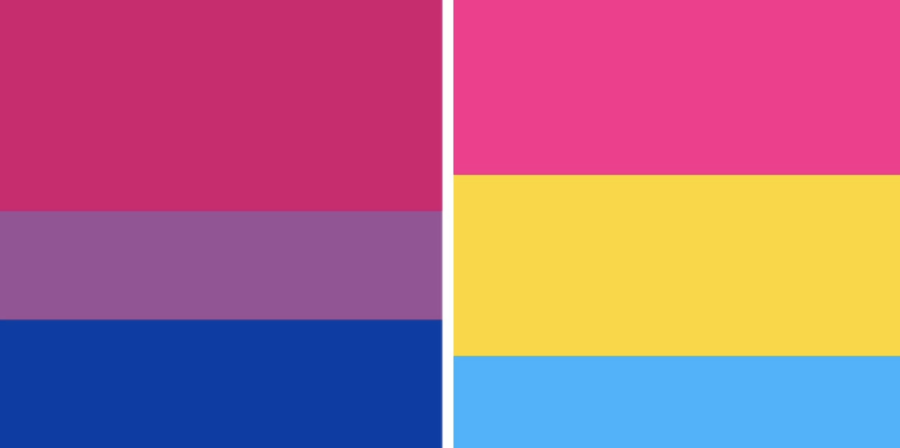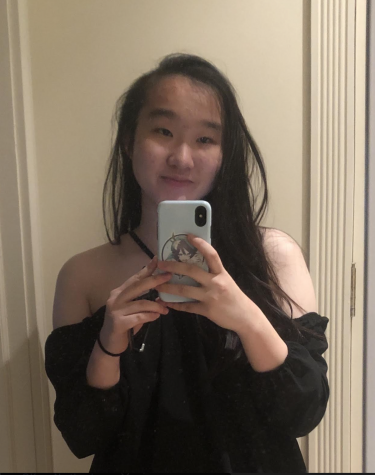Getting Straight on Not Being Straight
Just Being Different—The bisexual flag (left) was created in 1998 by designer Michael Page. It wasn’t until 2010 when the pansexual flag (right) emerged. An LGBTQ+ activist online sought to create a flag that was consistent with other pride flags and allowed pansexuals to differentiate from bisexuals.
April 13, 2022
Society sometimes makes sexuality restrictive: identities become labels, niches, even slurs. However, labels are only as demeaning or powerful as we make them. I was afraid of calling myself pan(sexual) again after I switched from pan to bi(sexual). This was around the eighth grade, when I started becoming more comfortable with and open about my sexuality.
For so long, the “bi” label was a crutch to me. In February 2022, during winter break, I decided I no longer cared about the conformity I’d always felt and began identifying as both bi and pan. You’re probably thinking “What do bi and pan mean?” or “What’s even the difference?” It took me a long time to understand what the difference between them was; it’s a bit nuanced, in fact. The definition may even be muddled to up to half of the LGBTQ+ community.
Before we start, let’s clear up a few common misconceptions about gender and sexuality. Sex (meaning the biological category of either male or female) does not equal gender. As Native American Writer Aiyyana Maracle puts it, “rather than seeing male and female as the end points on a straight line, try looking at [them] as fixed points sitting opposite one another on a circle.” Of course, gender can also exist on the entire circle or outside it entirely. Gender is a broad spectrum that ranges from femininity, masculinity, a mixture of both, nonbinary identity, or none at all. Gender does not have to correlate to sexuality. For example, someone can be nonbinary and still identify as a lesbian. Lesbianism doesn’t only apply to women, but includes nonbinary genders—really anything that isn’t a man.
Now, with the misconceptions cleared, let’s establish a basic definition of bisexual and pansexual. Bisexuality is the attraction to two or more genders, while pansexuality is openness to any or all genders and sexualities.
Many people are unaware of the fact that the purple stripe on the bi flag represents attraction to nonbinary genders. They see bisexuality as a dichotomy, perhaps because of its prefix of “bi-“. Bisexuality in itself is not a dichotomy, but rather a spectrum of its own. Bisexuality goes beyond attraction to both male and female. A bisexual person that identifies as female can be attracted to the opposite (male), same (female), and nonbinary genders. This means that someone who’s bi can be attracted to men and nonbinary people, or women and nonbinary people; they don’t have to be attracted to both male and female in order to be bisexual.
Pansexual, on the other hand, is similiar in some regard. To put it plainly, pansexuality refers to a focus on personality rather than gender. While that doesn’t exactly mean pansexuals “don’t care” about gender (at least not always), most pansexuals don’t consider gender to be a prevalent factor, if at all, when choosing a partner. A pan person has the capacity to be attracted to all genders, but don’t have to be attracted to all, just as bisexuals don’t have to be attracted to both male and female.
Past definitions separated pan from bi as being inclusive of transgender people. They defined pansexual as being attracted to male, female, transexuals, transgenders, etc. However, it’s 2022: trans people are people too, they aren’t their own separate category. Just because trans people don’t identify with the gender they were assigned at birth doesn’t mean society has to mark them specifically as trans. A trans man is still a man, and female to male (FTM) is not a gender of its own—it’s still male. And although bisexuality and pansexuality are different, they share attraction to multiple genders. That’s why some in the LGBTQ+ community identify with both instead of one over the other.
Pansexuals can have a preference for attraction to one gender over another. I can’t tell you how many times I’ve been told, “you can’t be pan with a preference.” No, you can totally be pan with a preference! A pan person may find themselves preferring a certain gender over the others because of physical, emotional, or social aspects. Pansexuals don’t limit their choice of partner to just be a matter of gender, while bisexuals may care more about the way someone identifies/expresses their gender.
The main point is this: pansexuality doesn’t mean you don’t care about gender, and bisexuality doesn’t mean you’re attracted to both male and female. Gender and sexuality make LGBTQ+ people who they are. Learning to better understand gender and sexuality is a step closer to a world where such trivial things don’t matter, and people are accepted no matter how they identify.






